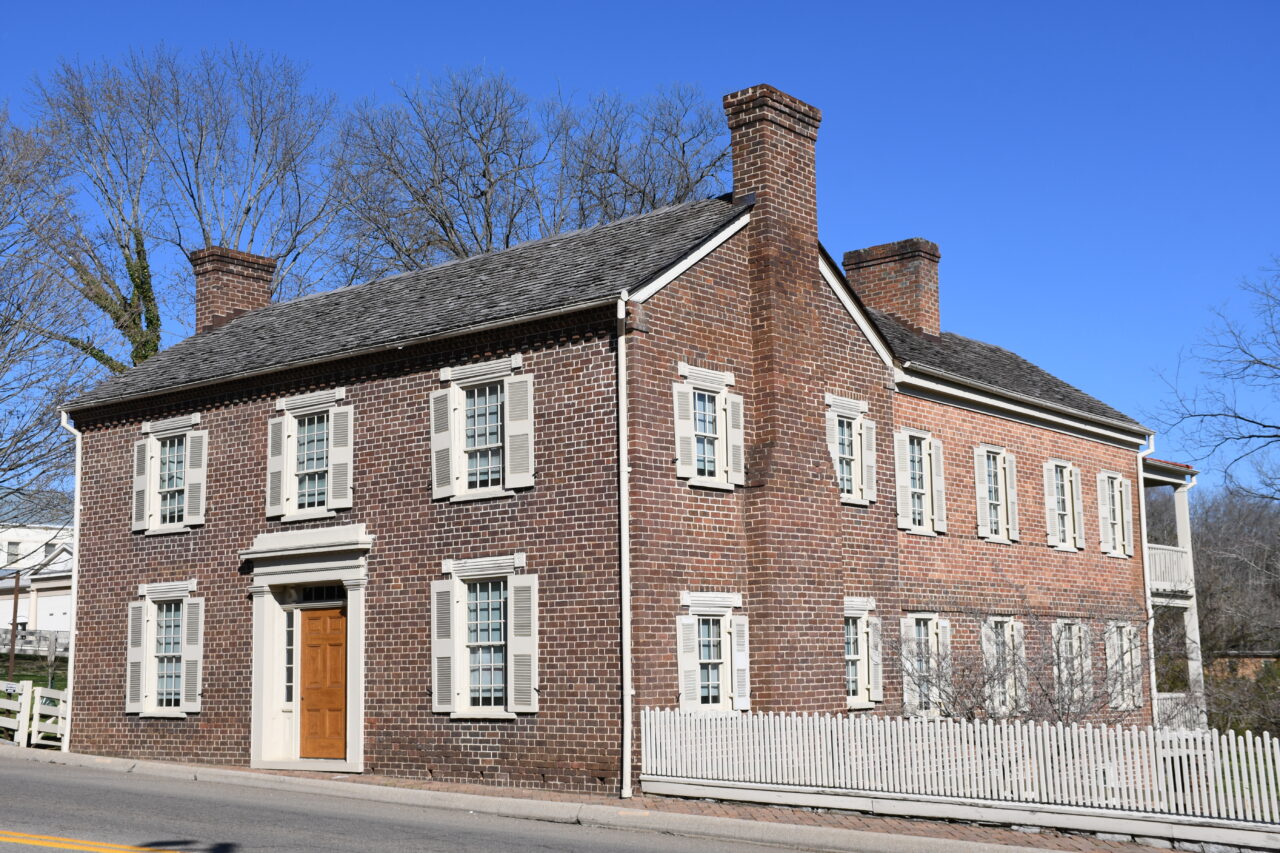Get more Andrew Johnson National Historic Site Travel Tips & News here!
Where is Andrew Johnson National Historic Site located?
The Andrew Johnson National Historic Site is situated in Greeneville, Tennessee, a charming town located in the northeastern part of the state. Greeneville is known for its rich historical significance, particularly as the birthplace of Andrew Johnson and its connections to the Civil War. Nestled in the Appalachian region, the town features beautiful landscapes, rolling hills, and a vibrant community. Visitors can enjoy exploring the historic downtown area, which boasts a variety of shops, restaurants, and local attractions that reflect the region’s heritage. The site itself is easily accessible and serves as a focal point for those interested in American history.
Best Time to Visit Andrew Johnson National Historic Site
The best time to visit the Andrew Johnson National Historic Site is during the spring (March to May) and fall (September to November) seasons. During these months, the weather is typically mild, making it comfortable for outdoor exploration. Spring brings blooming flowers and vibrant greenery, while fall offers stunning foliage. Summer can be quite hot, with temperatures often exceeding 90°F, which may deter some visitors. Additionally, the site may experience higher crowds during summer vacation periods, particularly in July. Winter months can be chilly, but fewer visitors mean a more peaceful experience. Be sure to check for any seasonal closures or special events that may enhance your visit.
How to get to Andrew Johnson National Historic Site?
Traveling to the Andrew Johnson National Historic Site is convenient, thanks to its proximity to several airports. The nearest major airport is Tri-Cities Airport (TRI), located about 40 miles from Greeneville. This regional airport offers flights from various hubs, making it accessible for travelers from across the United States. Alternatively, visitors can fly into McGhee Tyson Airport (TYS) in Knoxville, approximately 70 miles away, which provides a broader range of flight options. For those preferring a scenic drive, several well-maintained highways connect Greeneville to major cities in Tennessee and neighboring states.
What to do when you arrive:
Upon arrival at the Andrew Johnson National Historic Site, your first stop should be the Visitor Center. Here, you can gather valuable information about the site, including maps, brochures, and details on guided tours. The Visitor Center features exhibits that provide context about Andrew Johnson’s life, political career, and the historical period in which he lived. For accommodations, Greeneville offers various hotels and inns that cater to different budgets. Staying in town not only provides easy access to the historic site but also allows you to explore local dining options and attractions.
Getting Around Locally
Getting around Greeneville is relatively easy, as the town is small and walkable. Many of the historical sites and attractions are located within a short distance of each other, making it convenient for visitors to explore on foot. If you prefer to drive, there are several parking options available near the Andrew Johnson National Historic Site. For longer excursions or visits to nearby attractions, having a car can be beneficial. Public transportation options are limited, so renting a vehicle or using ride-sharing services may be the best choice for those looking to explore the broader area.
Top Things to Do and See at Andrew Johnson National Historic Site:
- Andrew Johnson’s Home: This historic house served as the residence of Andrew Johnson during his presidency. The home has been preserved to reflect the period and offers guided tours that highlight the life of Johnson and his family.
- Visitor Center: The Visitor Center features engaging exhibits that delve into Johnson’s life and the challenges of Reconstruction. The staff is knowledgeable and can provide insights into the various aspects of Johnson’s presidency and legacy.
- Andrew Johnson National Cemetery: Located adjacent to the historic site, this cemetery is the final resting place of Andrew Johnson and his family. Visitors can walk through the serene grounds and pay their respects while learning about the significance of the site.
- Historic Greeneville: Take time to explore the surrounding area, where you can find other historical sites, such as the Greene County Courthouse and the Davy Crockett Birthplace State Park, which celebrate the region’s rich heritage.
- Guided Tours and Programs: Participate in ranger-led tours and educational programs offered at the site. These activities provide deeper insights into Andrew Johnson’s impact on American history and the Reconstruction era.
Suggested Itineraries
When planning your visit to the Andrew Johnson National Historic Site, consider the following suggested itineraries:
- One-Day Itinerary: Start your day at the Visitor Center for an overview of the site. Explore Andrew Johnson’s Home and take a guided tour. Afterward, visit the Andrew Johnson National Cemetery. Spend your afternoon wandering through historic Greeneville, stopping for lunch at a local café.
- Weekend Itinerary: On the first day, follow the one-day itinerary. On the second day, extend your exploration by visiting nearby attractions, such as the Davy Crockett Birthplace State Park, where you can enjoy outdoor activities and learn about another important figure in American history.
Permits & Fees
Visiting the Andrew Johnson National Historic Site is free of charge, with no admission fees required. However, certain special programs or events may have associated costs. Be sure to check the official National Park Service website for the latest information on any permits required for specific activities or events. Donations are appreciated to help maintain and preserve the site for future generations.
Nearby Day Trips & Detours
Greeneville serves as an excellent base for exploring the surrounding region. Consider these nearby day trips:
- Davy Crockett Birthplace State Park: Located about 30 miles from Greeneville, this state park offers hiking trails, fishing, and interpretive programs celebrating the life of the legendary frontiersman.
- Roan Mountain State Park: Approximately 40 miles away, this park features stunning mountain views, over 30 miles of hiking trails, and opportunities for camping and fishing.
- Johnson City: Just a short drive from Greeneville, Johnson City is home to shopping, dining, and attractions like the Hands On! Discovery Center, perfect for families.
Local Culture & History
Greeneville is steeped in history and culture, making it a fascinating destination for visitors. The town played a significant role during the Civil War and is known for its well-preserved historic buildings. The local culture reflects a blend of Appalachian traditions and Southern hospitality, providing a warm welcome to visitors. Festivals and events throughout the year celebrate the town’s heritage, including the popular Greeneville Arts Council’s annual arts festival, which showcases local artists and musicians. Engaging with the community and participating in local events can enhance your understanding of the region’s history and culture.
Where to Stay in Andrew Johnson National Historic Site
Finding the right place to stay during your visit to the Andrew Johnson National Historic Site enhances your experience. Greeneville offers a variety of accommodations, catering to different preferences and budgets.
- Residence Inn by Marriott Greeneville – Perfect for families or extended stays, this hotel features spacious suites, a fitness center, and complimentary breakfast.
- Hampton Inn Greeneville – A comfortable option with modern amenities, including free Wi-Fi and breakfast, located conveniently near downtown Greeneville.
- Quality Inn Greeneville – A budget-friendly hotel offering essential amenities, ideal for travelers looking for value.
- Airbnb Options – Explore a range of unique accommodations, including private homes, cabins, and even yurts, perfect for a more personalized stay.
- KOA Greeneville – For those who enjoy camping, this KOA offers tent sites, RV hookups, and cabins, surrounded by beautiful natural scenery.
Dining Options
Greeneville presents a variety of dining options to suit every palate, from quick bites to sit-down meals. Whether you’re in the mood for local cuisine or familiar favorites, you’ll find plenty of choices.
- Pizza Hut – A popular spot for families, offering a range of pizzas and pasta dishes.
- Olive Garden – Enjoy Italian-American cuisine with a cozy atmosphere, perfect for a family dinner.
- Dairy Queen – For a quick treat, stop by Dairy Queen for ice cream and fast food favorites.
- Bojangles’ Famous Chicken ‘n Biscuits – Experience Southern comfort food with fried chicken, biscuits, and flavorful sides.
- Local Cafés and Diners – Explore unique local spots like the Gathering Place for a taste of regional dishes and homemade desserts.
- Waffle House – A classic diner chain offering breakfast all day, ideal for early risers or night owls.
Travel Tips & Safety
When visiting the Andrew Johnson National Historic Site and surrounding areas, it’s essential to stay informed and prepared. Here are some travel tips and safety guidelines:
- Stay hydrated and carry plenty of water, especially during the warmer months.
- Apply sunscreen regularly to protect your skin from UV rays, particularly if you’re spending time outdoors.
- Wear a hat and sunglasses for additional sun protection.
- Check the local weather before your visit and dress accordingly.
- Be aware of wildlife and maintain a safe distance if you encounter any animals.
- Review national park safety guidelines to ensure a safe visit.
Stay updated with local alerts by visiting:
Packing List & What to Bring to Andrew Johnson National Historic Site
To ensure a comfortable and enjoyable visit to the Andrew Johnson National Historic Site, consider bringing the following items:
- Comfortable walking shoes for exploring the historic site and surrounding areas.
- A refillable water bottle to stay hydrated throughout your visit.
- Sun protection: sunscreen, sunglasses, and a wide-brimmed hat.
- Lightweight, breathable clothing suitable for varying weather conditions.
- A camera or smartphone to capture memorable moments.
- Binoculars for wildlife watching and enjoying the scenic views.
- A small backpack for carrying your essentials while exploring.
Wildlife & Nature Highlights
The Andrew Johnson National Historic Site is not only rich in history but also surrounded by beautiful natural landscapes and diverse wildlife. While visiting, keep an eye out for:
- Common Bird Species: Look for red-tailed hawks, cardinals, and blue jays in the area.
- White-tailed Deer: These graceful animals are often seen grazing in the woods surrounding the site.
- Various Plant Species: Explore the local flora, including native wildflowers and trees, which add to the area’s beauty.
- Seasonal Changes: Each season brings its own unique beauty to the landscape, making it worthwhile to visit year-round.
Consider participating in ranger-led programs focused on local wildlife to enhance your understanding of the ecosystem.
Accessibility Information
The Andrew Johnson National Historic Site is committed to providing an accessible experience for all visitors. Here are some accessibility features:
- Accessible parking is available near the Visitor Center.
- The Visitor Center and exhibits are wheelchair accessible.
- Guided tours can accommodate visitors with mobility challenges; please inform staff of any specific needs.
- Restroom facilities are equipped with accessible options.
For additional questions regarding accessibility, contact the Visitor Center prior to your visit for assistance.
Andrew Johnson National Historic Site FAQs
Here are some frequently asked questions about the Andrew Johnson National Historic Site:
- Is there an entrance fee? No, admission to the site is free.
- Are pets allowed at the site? Pets are not permitted in the buildings but may be allowed in outdoor areas on a leash.
- What are the hours of operation? The Visitor Center typically operates from 9 AM to 5 PM, but hours may vary by season.
- Can I take photographs inside the buildings? Photography is encouraged in most areas, but check for specific restrictions in certain exhibits.
Additional Resources for Andrew Johnson National Historic Site
To further enrich your visit, explore these additional resources:
- Official National Park Service Page – Find in-depth information about the site, upcoming events, and educational resources.
- Greeneville City Government Website – Access local information, services, and community events during your stay.
- Tennessee Vacation – Greeneville – Discover more attractions and activities in the Greeneville area to enhance your trip.
Follow us on social media for more!


